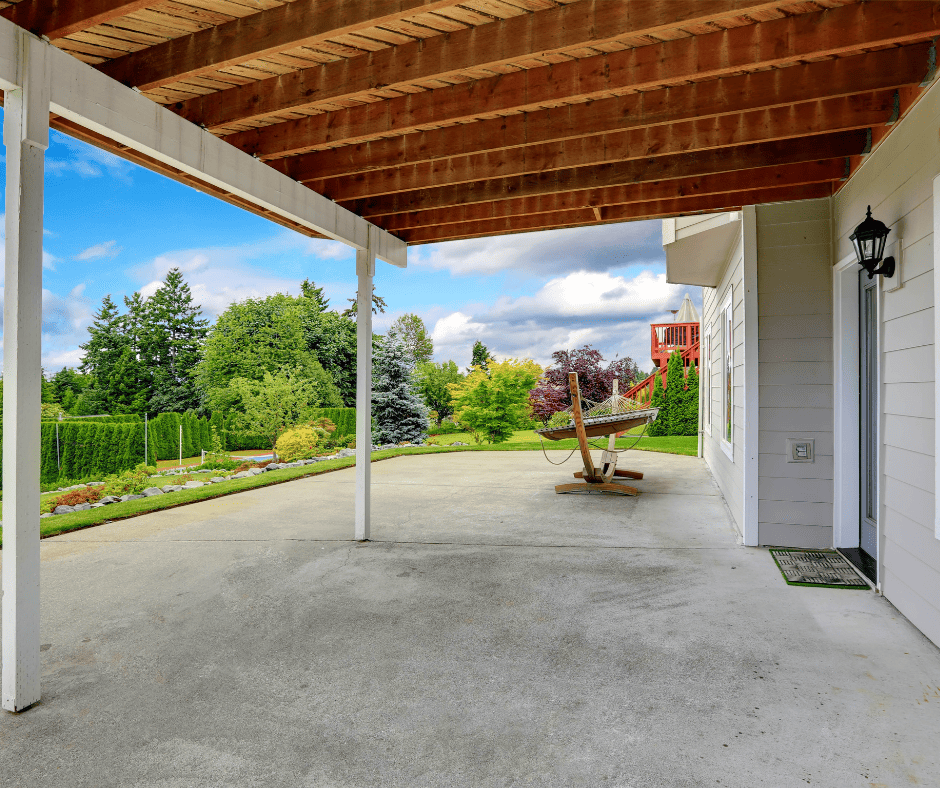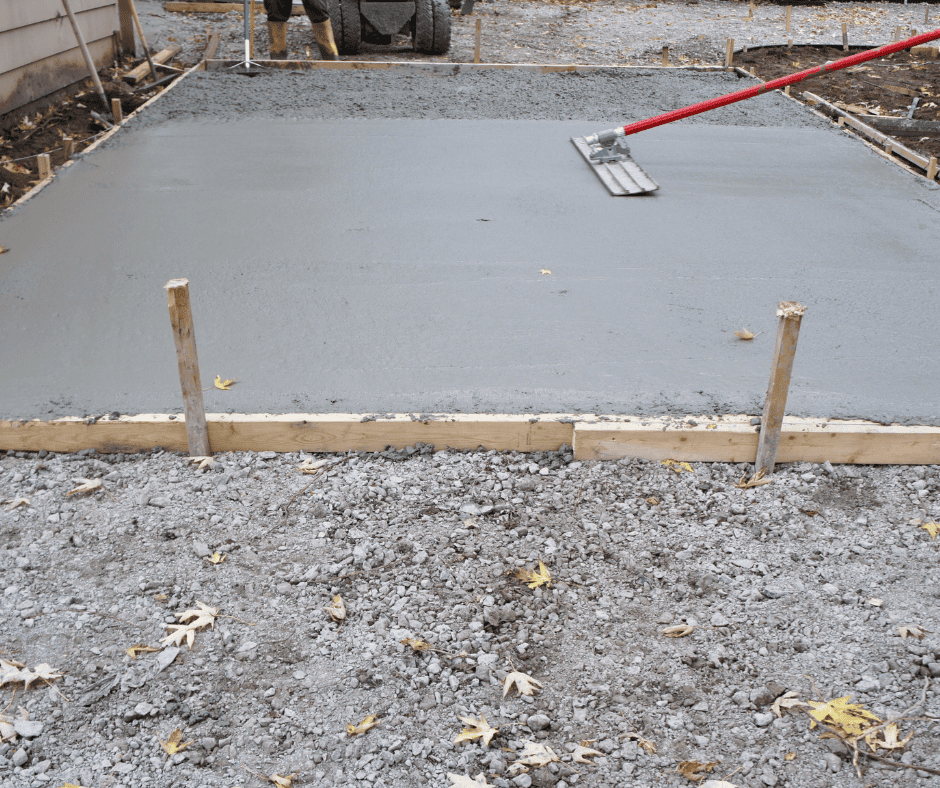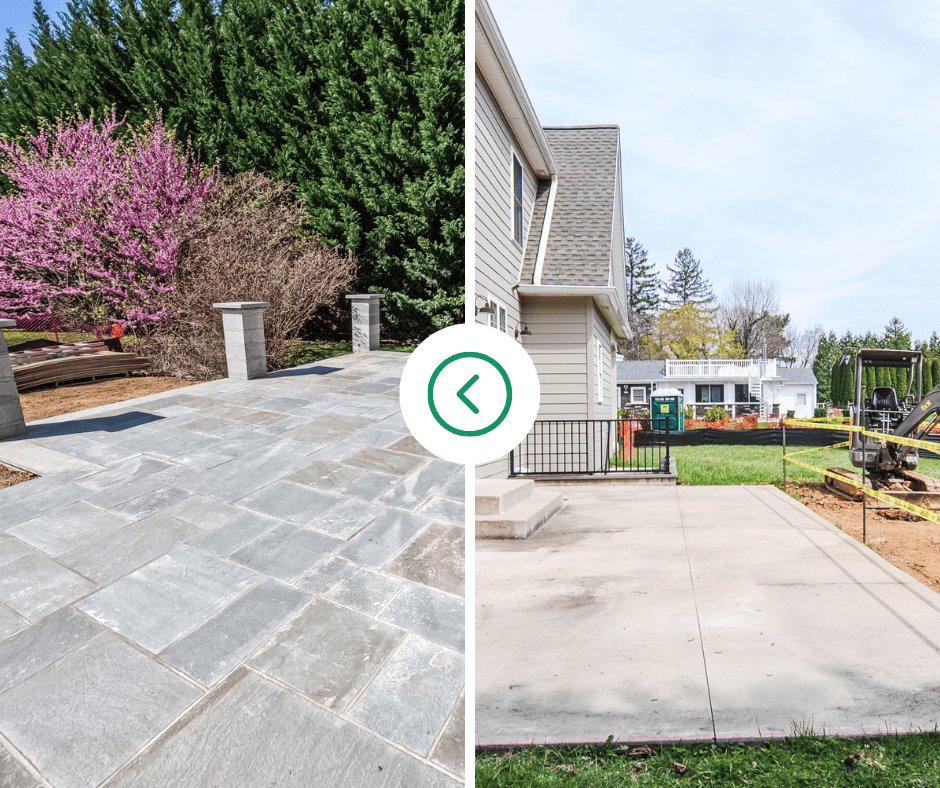A well-designed patio can transform your backyard into a beautiful and functional outdoor living space. Whether you love hosting summer barbecues, enjoying morning coffee in the fresh air, or simply having a quiet space to unwind, a patio adds value and convenience to your home. However, choosing the right material for your patio can be a challenge. With so many options available—wood, brick, pavers, and natural stone—concrete stands out as one of the most popular choices.
Concrete patios offer a range of benefits, from durability and affordability to aesthetic versatility. But like any material, they also have drawbacks, such as the potential for cracking and heat retention. In this article, we’ll explore the pros and cons of concrete patios, helping you determine if this option is right for your outdoor space.

The Pros of Concrete Patios: Why Homeowners Love Them
Durability & Longevity: Built to Last
One of the biggest reasons homeowners choose concrete for their patios is its exceptional durability. Unlike wood, which can rot, warp, or become infested with termites, concrete remains strong and resilient for decades. It can withstand heavy furniture, high foot traffic, and extreme weather conditions, making it a great long-term investment.
Concrete patios are particularly beneficial in areas that experience fluctuating temperatures. When installed correctly with proper reinforcement and expansion joints, they resist the wear and tear caused by seasonal changes. While other materials like brick or pavers may shift over time, concrete remains stable, ensuring a safe and sturdy surface for years to come.
Cost-Effectiveness: A Budget-Friendly Option
For homeowners who want an attractive and durable patio without breaking the bank, concrete is a cost-effective choice. Compared to natural stone, brick, or even some high-end pavers, concrete is significantly more affordable. The cost per square foot is lower, and because it requires minimal maintenance, the long-term expenses are also reduced.
In addition to the lower upfront cost, concrete patios do not require frequent repairs or treatments like wood decking, which needs to be stained or sealed regularly. By choosing concrete, homeowners can enjoy a stylish and functional patio without the ongoing financial burden associated with other materials.
Versatility & Aesthetic Options: More Than Just a Plain Slab
Gone are the days when concrete was limited to plain gray slabs. Today’s concrete patios offer a wide range of customization options, allowing homeowners to achieve stunning, high-end looks without the associated costs. Stamped concrete can mimic the appearance of natural stone, brick, or even wood, providing the aesthetic appeal of more expensive materials at a fraction of the price.
Homeowners can also choose from a variety of colors, stains, and finishes to complement their outdoor space. Whether you prefer a sleek modern look or a rustic charm, concrete can be tailored to match your vision. With so many design possibilities, a concrete patio can enhance your home’s curb appeal and increase its overall value.
Low Maintenance: Easy to Care For
Another major advantage of concrete patios is their low-maintenance nature. Unlike wood, which requires regular staining, or pavers, which may need periodic re-leveling, concrete requires minimal upkeep. A simple sweep and occasional wash with a hose and mild detergent are usually enough to keep it looking great.
Sealing the concrete every few years can help protect it from stains and weather damage, but this is a relatively low-cost and straightforward process. With minimal effort, a concrete patio can stay in excellent condition for decades, making it an ideal choice for homeowners who want a hassle-free outdoor space.

Environmental Benefits: An Eco-Friendly Choice
For environmentally conscious homeowners, concrete can be a sustainable option. Many concrete mixtures incorporate recycled materials, reducing waste and environmental impact. Additionally, compared to wood decks, which contribute to deforestation, concrete is a more sustainable choice.
Permeable concrete is another eco-friendly option, allowing rainwater to seep through and reduce runoff, which helps prevent erosion and water pollution. By choosing concrete for your patio, you can enjoy a beautiful outdoor space while also making a responsible choice for the environment.
The Cons of Concrete Patios: Consider These Factors
Prone to Cracking: A Common Concern
While concrete is highly durable, it is not entirely immune to damage. One of the biggest concerns homeowners face is cracking. Over time, concrete can develop cracks due to ground movement, temperature fluctuations, or heavy loads. Even with proper installation, small cracks may still appear over the years.

However, there are ways to minimize cracking. Proper site preparation, reinforcement with steel bars, and the inclusion of expansion joints can help prevent major damage. Additionally, sealing the concrete regularly can protect it from moisture infiltration, which can contribute to cracking.
Can Be Slippery When Wet: A Safety Hazard
Smooth-finished concrete patios can become dangerously slippery when wet, posing a safety risk for children, pets, and elderly individuals. This can be particularly concerning in areas that receive frequent rain or where water from pools and sprinklers might accumulate.
Fortunately, there are solutions to improve traction on concrete patios. Textured finishes, such as broom-finished or stamped concrete, can provide better grip. Additionally, non-slip sealants and coatings can enhance safety while maintaining the patio’s aesthetic appeal.
Limited DIY Installation Feasibility: Best Left to Professionals
Unlike pavers, which can be installed by homeowners with a bit of patience and effort, concrete patios require professional installation. Pouring and finishing concrete correctly is a complex process that requires specialized equipment and experience. Improper installation can result in uneven surfaces, weak spots, or premature cracking.
Because of this, hiring a professional contractor is essential for a high-quality concrete patio. While this adds to the initial cost, it ensures a durable and visually appealing result that will stand the test of time.
Heat Retention: Can Get Uncomfortably Hot
Concrete absorbs heat, which means that during the summer months, your patio can become uncomfortably hot to walk on. This can be a drawback for families who enjoy spending time barefoot outdoors.
To counteract this issue, homeowners can choose lighter-colored concrete, which reflects heat rather than absorbing it. Shade structures, such as pergolas or umbrellas, can also help keep the patio cool. Additionally, outdoor rugs or mats can provide a comfortable walking surface on hot days.
Permanence & Difficult Repairs: Not Easily Adjustable
Unlike pavers, which can be lifted and replaced individually, repairing a damaged concrete patio can be more challenging. If a section of the patio cracks or becomes stained, the entire area may need to be resurfaced or repoured.
However, concrete overlays and resurfacing options can help restore a patio’s appearance without complete replacement. By taking preventive measures, such as sealing and proper installation, homeowners can minimize the likelihood of costly repairs.

Is a Concrete Patio Right for You?
Deciding on the best material for your patio depends on several factors, including budget, maintenance preferences, and climate. If you value durability, affordability, and design flexibility, a concrete patio could be an excellent choice. However, if you’re concerned about cracking, heat retention, or difficult repairs, you may want to consider alternatives like pavers or composite decking.
Before making a decision, ask yourself:
- How much maintenance am I willing to do?
- Do I need a slip-resistant surface?
- Will I be comfortable with a permanent installation?
Trust the Experts for Your Concrete Patio
If you’re considering a concrete patio for your home, it’s essential to work with experienced professionals to ensure the best results. Kelly Masonry specializes in high-quality concrete patio installation, offering expert craftsmanship and customized designs to suit your outdoor space. Their team ensures durability, functionality, and aesthetic appeal, helping you create the perfect backyard retreat.
Contact Kelly Masonry today to get started on your dream patio!
